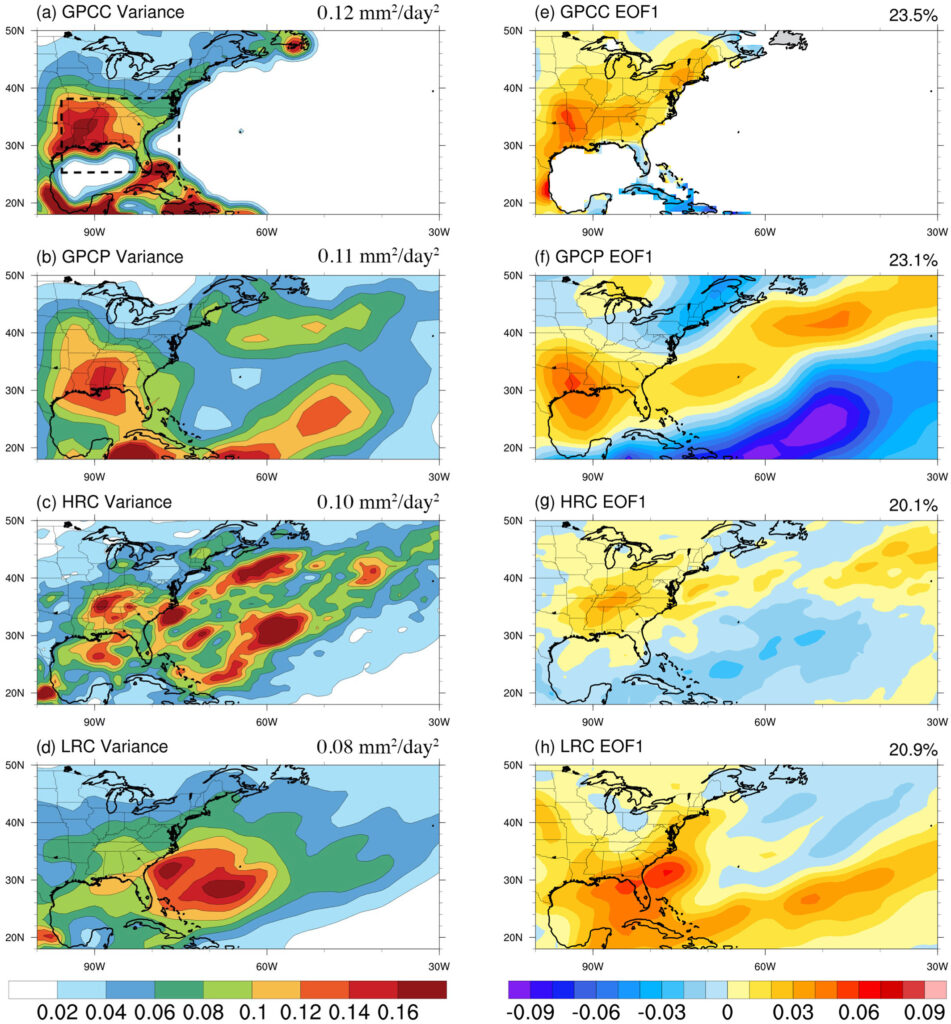A new study has identified connections between oscillations in the Gulf Stream and long-term rainfall expectations in the Southeastern U.S.—a finding made possible by the supercomputing resources at the University of Miami Institute for Data Science and Computing (IDSC).
“While oceanographers recognize that eddies or  oscillations in powerful currents can affect the world’s climate, our study was the first to show that changes to the Gulf Stream affect rainfall expectations in the Southeastern U.S. over a 10-year period,” said Ben Kirtman, Ph.D., IDSC Deputy Director, Rosenstiel School of Marine and Atmospheric Science Professor of Atmospheric Sciences, and Director, National Oceanic and Atmospheric Administration (NOAA) and UM Cooperative Institute for Marine & Atmospheric Studies (CIMAS).
oscillations in powerful currents can affect the world’s climate, our study was the first to show that changes to the Gulf Stream affect rainfall expectations in the Southeastern U.S. over a 10-year period,” said Ben Kirtman, Ph.D., IDSC Deputy Director, Rosenstiel School of Marine and Atmospheric Science Professor of Atmospheric Sciences, and Director, National Oceanic and Atmospheric Administration (NOAA) and UM Cooperative Institute for Marine & Atmospheric Studies (CIMAS).
“Because rainfall levels impact many aspects of our economy, including agriculture, water supply, and ecosystems as well as emergency planning, there are many benefits to forecasting potential droughts or flooding conditions over the long term,” added Kirtman. “That’s one reason the U.S. Department of Energy and NOAA are making big investments in improving climate models and rainfall forecasts.”
Kirtman and Leo Siqueira, Ph.D., Assistant Scientist, were coauthors of the collaborative study, “Decadal Variability of Southeast U.S. Rainfall in an Eddying Global Coupled Model,” published recently in Geophysical Research Papers. “Our high-resolution model provides a better representation of the air-sea interactions between the sea surface temperature and low-level atmosphere over the Gulf Stream, allowing us to model rainfall variations over the Southeast U.S.,” Kirtman said.
 For the first time, the research team was able to take a detailed look at the Gulf Stream eddies or oscillations at the 10-kilometer (6.2-mile) level. “This is a dramatic increase in resolution from prior studies that could only resolve ocean current behavior at 100 kilometers,” said Kirtman. The improvement is particularly important because the Gulf Stream is only 50 to 60 kilometers wide as it flows north from the Florida Straits into the cold waters of the North Atlantic Ocean. “Analyzing the vastly larger data set to reproduce how the Gulf Stream interacts with the atmosphere would not have been possible without the UM supercomputers,” he added.
For the first time, the research team was able to take a detailed look at the Gulf Stream eddies or oscillations at the 10-kilometer (6.2-mile) level. “This is a dramatic increase in resolution from prior studies that could only resolve ocean current behavior at 100 kilometers,” said Kirtman. The improvement is particularly important because the Gulf Stream is only 50 to 60 kilometers wide as it flows north from the Florida Straits into the cold waters of the North Atlantic Ocean. “Analyzing the vastly larger data set to reproduce how the Gulf Stream interacts with the atmosphere would not have been possible without the UM supercomputers,” he added.
Ocean variability is an important factor in developing rainfall predictions, according to Kirtman. He noted that many prior climate studies have shown that changes to the Pacific current El Niño impact rainfall levels in the western states and the Southeast, particularly in winter.

Decadal variance and leading EOR patterns (unit: mm/day) of monthly rainfall anomalies over the Southeast US and western North Atlantic region: (a), (e) GPCP, (b), (f) GPCP, (c), (g) LRC, and (d), (h) HRC. The land region within the black dashed box (25 to 38º N, 266 to 284º E; with ocean grids excluded) indicates the region of the Southeast US. Values of decadal SEUS rainfall variance for each observation and model simulations are shown on the top left corner of (a)-9d). All the data have been applied with a 5-year low-pass filter before analysis.
Looking at the Southeast U.S. in the summer, the researchers found that when the Gulf Stream interacts with the atmospheric North Atlantic Subtropical High driving it further east, rainfall levels are suppressed over a 10-year period. But when the Gulf Stream drives the North Atlantic Subtropical High further west, closer to the U.S. coast, the reverse is true. Based on the new model, the Southeast is now in the middle of a more active period with an increased likelihood of summer thunderstorms and tornadoes, added Kirtman.
Reflecting on the study, Kirtman said, “The ability to predict long-term rainfall variability over land remains one of the grand challenges in climate prediction. Better models and simulations using the power of supercomputers have great potential to improve our forecasts and benefit our society.”
, , , , , & (2022). Decadal variability of Southeast US rainfall in an eddying global coupled model. Geophysical Research Letters, 49, e2021GL096709. https://doi.org/10.1029/2021GL096709
Tags: Air-Sea Interactions, Ben Kirtman, Climate, Leo Siqueira, Ocean Variability, Rainfall, Weather Forecasting



